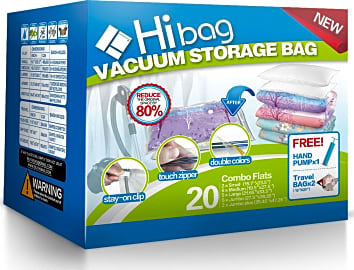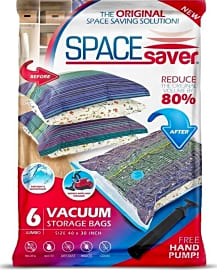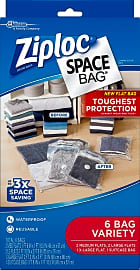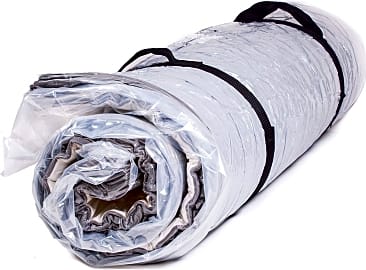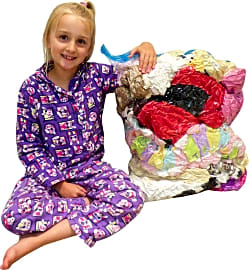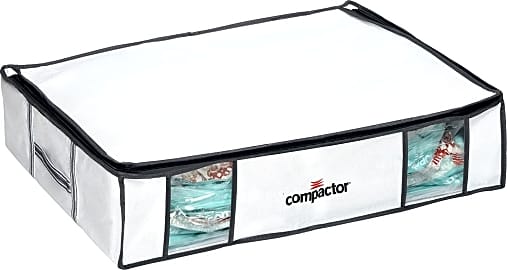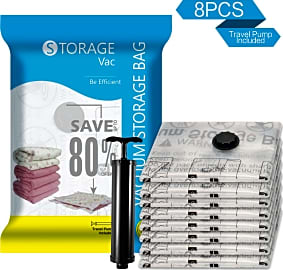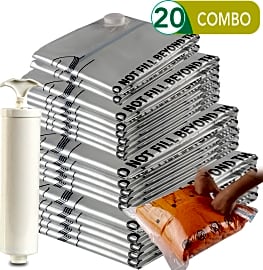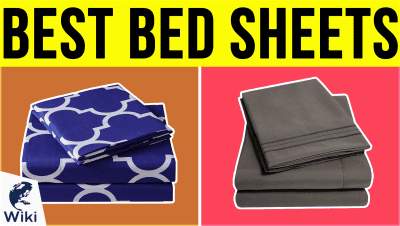The 10 Best Vacuum Storage Bags

This wiki has been updated 34 times since it was first published in March of 2017. So much stuff, so little room for storage. That is a dilemma many families face. But these handy space saver bags can be a huge help. We've selected options that can compress even the fluffiest comforters or sweaters down to a minimal thickness. Most of these attach easily to a regular vacuum cleaner, which makes sucking the air out of them as simple as pressing a button. When users buy our independently chosen editorial picks, we may earn commissions to help fund the Wiki.
Editor's Notes
July 24, 2020:
At this time, we've elected to keep popular, standard vacuum storage bags, including the SpaceMax Premium, the Spacesaver Original, and the Hibag Combo, but we've also added a couple of options that are slightly different. These include the Fidelity Seller Jumbo, which is sized for transporting a mattress, whether it is a California king, queen, or twin. It comes with straps that allow you to roll the whole thing up once it's sealed, and these also function as carrying handles to make transport a breeze. You shouldn't plan to store a mattress like this over the long term, however, as the bag wasn't made for holding the seal indefinitely.
For storing all of your bulky blankets, comforters, and sheets under your bed, we've added the Compactor Storage System. It has two parts, an interior vacuum bag and a zippered case that the bag packs down into. You can slide it easily under your furniture, and it even comes in several colors, so you aren't necessarily stuck with plain white.
Finally, we opted to remove the Sodynee VSB and the Home-Complete Reusable over concerns about their long-term durability. Note, though, that most of these bags should be treated gently, as the plastic can rip with rough treatment.
June 12, 2019:
Whether in a big house or a cramped apartment, most people never seem to have enough room for storage. Luckily, these vacuum bags can help you regain some space. Our top choices still include the SpaceMax Premium and the Vacwel Extra Strong, both of which are a good value for the cost as well as simple to use. We then decided to add the Hibag Combo, which comes with a whopping 20 bags as well as two bonus travel size bags. This should be more than enough storage space for even the most ample of wardrobes. After some consideration, we kept the popular Spacesaver Original, although they don't seem to be quite as rip-resistant as some. They're also on the more expensive side.
For travel, we still like The Chestnut Sacks, which are handy roll-up bags. Consider these a good option for the type of journey where you arrive, stay awhile, then pack up and leave. If you are hopping from place to place, meaning you'll be in and out of your packed clothing constantly, then they may be more hassle than they're worth. But no matter which type or brand you choose, note that it's often not a good idea to store wool and other natural fibers in extreme compression indefinitely. These fibers tend to do better when they can breathe, so you may want to store them for a season at a time or rotate which items are stored.
Benefits Of Vacuum Storage Bags
They also act as a barrier against mildew, mold, moisture, and dust.
Vacuum storage bags are one of the best ways to store clothes, bedding, and other textiles. They are suitable for both long-term storage and travel. They work by compressing the contents of the bag, either through the use of a vacuum cleaner or handheld pump. This makes them ideal for people who have limited storage space.
Using a vacuum storage bag allows you to bring along more clothes on your next vacation, without having to worry about paying for additional pieces of luggage. Most clothing, bedding, and textiles can be compressed down to a fraction of their original size by vacuum storage bags. This means you'll be able to fit more clothes into your current luggage, instead of stepping up to the next larger size. Since airlines rarely take the time to weigh carry-ons, compressing your clothes with a vacuum storage bag and shoving it into your carry-on is often a great way to bypass overweight baggage fees, as well.
When it comes to long-term storage, even if space isn't a limitation, it is often important to protect your clothes and bedding from potentially harmful elements. Sheets, blankets, jackets, and other clothing can often pick up an unpleasant scent when stored in the attic for an extended period of time. They are also susceptible to damage from clothes moths and other pests. Vacuum storage bags act like a barrier to keep out pests and unpleasant odors. They also act as a barrier against mildew, mold, moisture, and dust. There really is no better way to keep stored clothing and bedding in optimal condition in between uses.
Tips For Using Vacuum Storage Bags
Using vacuum storage bags is pretty easy, and most will find the operation self-explanatory. As easy as they may be though, there are a few simple tips that can help ensure you get the maximum protection for your clothing and textiles. One of the most important things to remember is that anything put inside of one of these bags must be completely dry. If any of your clothing or bedding is even the slightest bit damp, it significantly increases the risk of mold or mildew growing inside of the bag. This will not only affect the damp article, but everything else stored inside of the same bag. You should also take care to only store clean clothes and bedding. Putting unwashed materials inside of a vacuum storage bag and leaving them inside for a long period of time can magnify unpleasant smells. It will also cause everything else inside the same bag to pick up a similar odor.
One of the most important things to remember is that anything put inside of one of these bags must be completely dry.
When packing away your clothes and other items, make sure you are using the correct size bag. One of the main causes of vacuum storage bag failure is over packing. It is better to use a bag that is slightly larger than you need, than one that is slightly too small. Do not pack your clothes right up to the zipper closure, either. Always leave a couple of extra centimeters between your clothes or blankets and the zipper. It is almost impossible for any zippered bag to keep out air completely and indefinitely. This means that pretty much all vacuum storage bags will slowly let air leak in over time. Having a few centimeters between your clothing and the zipper allows for a plastic to plastic seal right next to the zipper. This helps to improve the vacuum and minimize the amount of air that leaks into it.
As you are vacuuming the air out of your bag, continuously pat down the areas further away from the suction valve. This helps to ensure that little pockets of air don't get trapped anywhere. It also helps the sealed bag achieve a more uniform shape, which tends to make storing it easier. If you find that your clothes have moved a little too close to the zipper when sucking the air out, unzip the bag and move them. Since your have just vacuumed out all of the air, you will most likely find that your items fit inside of the bag a little bit better. After readjusting your clothes and other textiles, reseal the bag and vacuum out all of the air once again.
As a general rule of thumb, you should never put hard or sharp objects inside of vacuum storage bags, as this will often cause tears or punctures during the vacuuming process, transport, or storage. If you must store a hard or sharp object inside one of these bags, always put it between many layers of clothing, blankets, towels, or other soft materials.
A Little Bit About Vacuum Sealing Technology
The concept of vacuum packing food, goods, and other items is not new. In fact, people have been experimenting with vacuum sealing since the early 19th century. It wasn't until after WWII that vacuum packing food really took off, though. Vacuum packing refers to any method of removing air from a package or container before sealing it. Removing oxygen from a flexible container before sealing it can significantly reduce the volume. It also extends the shelf life of food.
Vacuuming packing and sealing reduces or eliminates the atmospheric oxygen inside of a container.
Vacuuming packing and sealing reduces or eliminates the atmospheric oxygen inside of a container. This helps to limit the growth of fungi and bacteria. It can also prevent the evaporation of volatile components. This makes it the ideal technology to use with foods that would otherwise spoil quickly. The less available atmospheric oxygen, the harder it is for bacteria and fungi spores to grow. Since shelf life isn't a concern with non-consumable items like clothing, bedding, and other textiles, vacuum sealing is mostly used for volume reduction and protection.
An alternative to vacuum packing is modified atmospheric packaging. This involves replacing the atmospheric oxygen inside of a package with a different gas, most often nitrogen or carbon dioxide. This has the same effect of inhibiting bacterial growth from oxygen, but since it doesn't compress the package, it is better suited to delicate foods that might be damaged in the vacuuming process.


